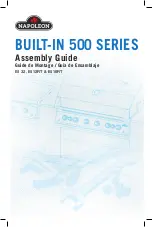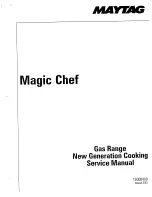
3
20. CLEAN STOVE FREQUENTLY as soot, creosote and ash may accumulate. Empty ash pan frequently. Build-up
of ash can block air flow to the fire and/or damage the grate. Dispose of ash properly (see #14.)
21. ALERT ALL PERSONS TO THE HAZARDS OF HIGH SURFACE TEMPERATURES while stove is in operation – especially
young children. Keep away from a hot stove to avoid burns or clothing ignition.
22. NEVER LEAVE SMALL CHILDREN UNSUPERVISED WHEN THEY ARE IN THE SAME ROOM AS THE STOVE. If small
children will be in the same room as the stove during operation, provide a sturdy barrier to keep them at a
safe distance from the stove.
23. Keep stove area clear and free from al l combustible materials, gasoline, engine oil, naphtha and other
flammable vapors and liquids.
24. WHILE TENDING THE FIRE ALWAYS WEAR PROTECTIVE CLOTHING, fire retardant hearth gloves and eye
protection, to prevent burns.
25. Never operate this stove without the ash clean-out door open or ash drawer removed. Such actions can
result in very dangerous operating conditions.
26. DO NOT OVER FIRE THE STOVE. Over firing will occur if combustion air is uncontrolled as when ash clean-out
door is left open during operation. Such actions can result in very dangerous operating conditions. While in
operation, keep the ash clean-out drawer in place and the ash door closed and secured at all times except
while tending the fire.
27. Do not load the fuel to a height or in such manner that it would be hazardous when opening the lids.
28. NEVER LEAVE THE STOVE UNATTENDED when the door is open. Always close the door after ignition.
29. DO NOT CONNECT TO OR USE IN CONJUNCTION WITH ANY AIR DISTRIBUTION DUCT WORK UNLESS SPECIFICALLY
APPROVED FOR SUCH INSTALLATIONS.
30. THIS STOVE MUST NEVER BE INSTALLED IN A HALLWAY OR NEAR A STAIRCASE, as it may block egress in the
event of a fire.
31. DO NOT INSTALL IN AN ALCOVE OR INSIDE A FIREPLACE.
32. Install at least one smoke detector on each floor of your home. Detectors should be located away from
the heating appliance to avoid false alarms. Detectors should be located close to sleeping areas. Follow
the smoke detectors manufacturer’s placement and installation instructions. Maintain smoke detector per
manufacturer’s instructions.
33. CARBON MONOXIDE (CO) HAZARD. A build-up of CO fumes is toxic and can be fatal. Carbon Monoxide
is a colorless, odorless gas produced during combustion of wood, coal, oil, gas and by other fuel burning
appliances. It is important to have a proper draft and adequate replacement air ventilation so fumes
are drawn out the chimney. Installed as instructed this stove is designed to be as safe as possible yet it is
recommended to install a CO detector. Follow the manufacturer’s recommendations for proper installation
and use. It is recommended to be placed at table-top level (not near the ceiling) to avoid false alarms.
Realize that devices other than a stove (i.e. motor exhaust) can trigger CO alarms.
If alarm sounds:
• Recognize the symptoms of CO poisoning (headaches, nausea & drowsiness).
• Increase ventilation (open windows & doors).
• Make sure stove doors and/or lids are closed and secured.
• Check stove for smoking or puffing (open airflow controls).
• Check chimney & connector pipe for leaks, blockage or down-draft conditions.
• Check CO device for false alarm.
34. Keep power cords, electrical appliances and/or assemblies outside of the clearance area shown in this
manual for combustible materials.
35. Consult your municipal building department or fire officials about restrictions, permits and installation
requirements for your area.
36. For further information on using your stove safely, obtain a copy of the National Fire Protection Association
(NFPA) publication, “Using Coal and Wood Stoves Safely” NFPA No. HS-10- 1978. The address of the NFPA is
Batterymarch Park, Quincy, MA 02269.
NOTE:
A professional, licensed heating and
cooling contractor must be consulted if you
have questions regarding the installation of
this solid fuel burning appliance.
Содержание THE RANCHER SR57E
Страница 19: ...19 NOTES ...




































